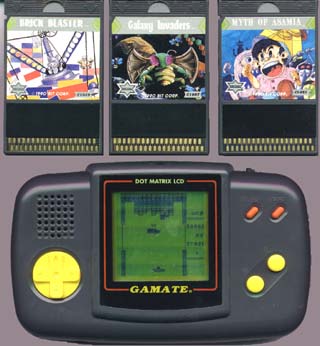Gamate and 3 games. Image from here, courtesy of Miguel Duran of Museo 8 Bits.
Background/History:
After the Game Boy came out in 1989, numerous competitors came out to compete in the handheld market. All three major Nintendo competitors had one; Sega had the Game Gear, Atari had the Lynx, and NEC had the Turbo Express, which was literally a portable Turbo Grafx 16. These four were by no means the only handheld competitors. Spurred by the new market and lower cost of developing a handheld, several companies offered handheld video game systems.
One of these systems was called the Gamate, launched in 1990. It was created by Bit Corporation, a Taiwanese video game company active from 1982-1992. Bit was known for its Atari 2600 games and software compatible clones of other systems, such as the Famicom, Atari 2600, Sega SG-1000, and Colecovision. Many of their products were made under different brand names, such as Puzzy and Zimag. The company had worldwide reach, and many of their products never made it to US shores.
The Gamate was a Bit product that made it to US shores; in addition, it was sold all over the world. Australia, parts of Europe and Asia, and Argentina were the known regions the system saw release. Local distributors, not Bit itself, distributed the console.
The system used a card form factor for its games, as shown in the picture. It had an LCD screen, much like the Game Boy - no color and no back-light.
Bit Corporation went out of business in 1992, and a fellow Taiwanese company, United Microelectronics Corporation (UMC) and its subsidiary Funtech (known later for the Super A'Can) continued to produce the Gamate until at least 1993. The last game was released in 1995, by which time over 70 games had been released.
The serial number on the back of the Gamate indicates production year and order - for instance, "9142115" is the 42,115th Gamate produced in 1991.
There are two variants of the system's appearance. The G-1001 has an x-shaped D-pad, and the G-1002 has a + shaped D-pad. There is also a white Gamate with red buttons.
What Makes It Obscure?
The Gamate never sold in numbers comparable to the Game Boy or even the Sega, Atari, or NEC handheld offerings.
In addition, quality was in many ways lower than the Game Boy. While the system itself was assembled in a quality manner, the LCD screen quality was inconsistent. There were two different types of LCD screen on the Gamate - a "worse" one and a "better" one. Some units had the worse LCD, some had the better one. "Ghosting" - a blurry and faint appearance exhibited by objects on screen - was exhibited by the system, and was far worse on the "worse" LCD screen. The mono sound of the Gamate was distorted and of low quality if played without headphones; with headphones, the sound quality improved greatly, due to the fact that the system could only output stereo through the headphone jack.

No comments:
Post a Comment